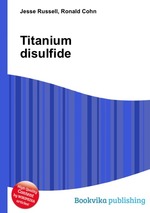Titanium disulfide
Jesse Russell Ronald Cohn
бумажная книга
High Quality Content by WIKIPEDIA articles! Titanium disulfide is a golden yellow solid with high electrical conductivity. It belongs to a group of compounds called transition metal dichalcogenides, which are ionic compounds of a transition metal cation bonded to two Group 16 anions (usually sulfur, selenium or tellurium). It has a hexagonal close packed structure (hcp). Furthermore, the structure of titanium disulfide is analogous to Cadmium iodide (CdI2) structure, in which half of the octahedral holes are filled with a cation. Cadmium iodide structure is common of d-metal halides and d-metal chalcogenides. Additionally, titanium disulfide is a semimetal, meaning there is small overlap of the conduction band and valence band. The large scale structure is essential to understanding the properties of titanium disulfide. S-Ti-S sheets are formed through covalent bonds. The adjacent S-Ti-S sheets are bound together by van der Waals forces, which are relatively weak intermolecular forces. Due to these weak forces, atoms or small molecules can intercalate between the layers. The Rigid-Band Model (RBM), which assumes that electronic band structure does not change with intercalation, describes how intercalation changes the electronic properties of titanium disulfide. The RBM shows that higher energy states are filled by extra charges from the intercalants. For example, the lithium 2s electron was analyzed for the effect of charge transfer into the vacant d-band of titanium disulfide.


